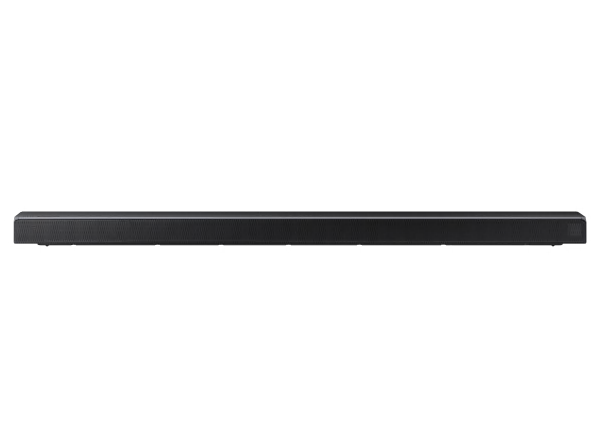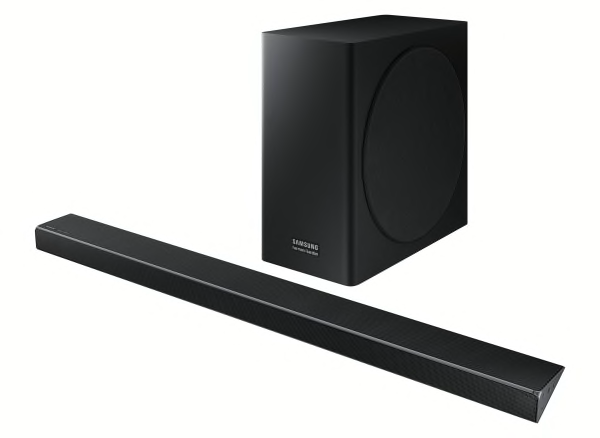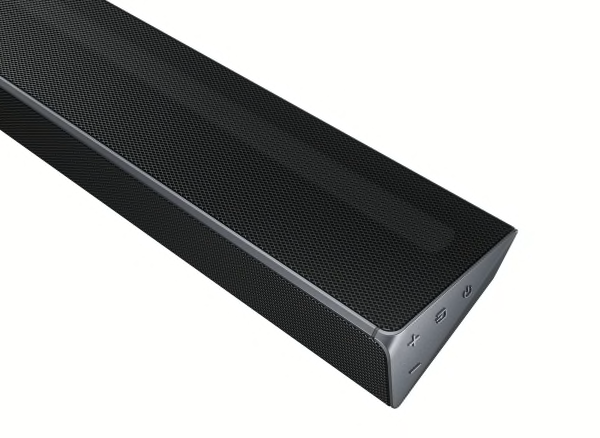Sound quality: Samsung's HW-Q7CR delivers sound quality that falls in the Good range - it reproduces music and dialog reasonably well despite the obvious shortcomings in its sound. In the Standard sound mode the bass has good impact, but is somewhat tubby and the deepest bass is lacking. The midrange is fairly even, but is a somewhat grainy, and a bit dark, etched, constricted, and echoey. The treble is fairly extended, but a touch prominent and slightly sizzly. This model does a decent job of recovering the actual room ambience of recordings (the sense of the acoustic space in which the music was recorded). With stereo program material sound field extends a bit above and beyond the width of the speaker array, and lacks front to back depth. The other Sound mode settings made the sound field wider and taller but also made the midrange sound harsh, metallic, and echoey. In the Standard sound mode with Dolby Digital and DTS multi-channel program material the sound image extends higher, and depending on the program material, may extend well past the sides of the soundbar, but still lacks depth. The other Sound mode settings had a similar effect with multi-channel program material as with stereo program material, but not as pronounced. When playing Dolby Atmos and DTS:X material the width and height of the sound stage expands, and depending on the program material, can fill the entire front of the room and the audio imaging can extend up to the ceiling, but not overhead or to the sides or rear. With DTS: X program material the may be some drop outs when sounds are intended to come from channels that are not actually there. Only the Standard sound mode is available when Dolby Atmos or DTS:X material is being played. There was no significant difference in sound quality between the HDMI, optical, Bluetooth, and WiFi inputs. Dolby Atmos and DTS:X program material can only be played through the HDMI input. The system can provide satisfying volume in a medium sized room.
TV setup and ease of use: Very Good overall. Setup: HDMI CEC (Samsung calls it Anynet+) setup is quick and straight forward, but you'll need to refer to the included instruction manual. When the HDMI ARC connection is not used the soundbar can still be controlled by TV remotes from Samsung and other major brands; activation and deactivation of this feature is quick and easy but not intuitive, so easy to follow instructions included with unit have to be referred to. The soundbar can also be set up to receive audio from some Samsung TVs via WiFi; the provided instructions are clear, but the setup is dependent on the TV so depending on the particular TV it may or may not be straight forward. All appropriate cables for wired TV connection are included. Ease of Use: This model can work seamlessly with many TVs - it can respond to the volume and mute commands from the remotes of HDMI CEC compatible TVs when connected via the HDMI ARC ports with and HDMI cable. It can also be set to respond to the volume and mute commands of the remotes of many TVs from major brands including Samsung, and to respond to some Samsung TV remotes when the TV is linked to the soundbar via a WiFi connection. Its own physical remote is uncluttered and has well labeled controls. App remotes that operate via WiFi can also be downloaded on to Apple and Android mobile devices; we found the sections of these apps that are used when watching TV to be easy to use and glitch-free. The soundbar console's power, source, and volume controls consist of raised symbols that are adequately sized but are black on a black background on the right side of the soundbar where they are not easy to see and may be hard to access. The console lacks a mute control, but if it is muted from the remote pressing one of the console volume buttons unmutes it. The display can be seen from the typical listening position; it can be used by itself or in conjunction with app remote screens. It momentarily shows power status, source selection, a numeric volume level, mute status, and the DSP effects mode. All settings except volume and mute can be recalled without changing the settings.
Features setup and ease of use: Good overall. Setup: Network streaming setup is done via WiFi, requires an app download to an Apple or Android mobile device, and is straight forward; the Android setup is a bit easier since it doesn't require inputting a WiFi network password while the Apple setup does. The soundbar must be registered with the manufacturer for network functionality; registration requires the users email and a password. Bluetooth pairing is very easy - if no Bluetooth device has previously been paired or the paired device does not have Bluetooth activated the unit is automatically in pairing mode once the remote's dedicated Bluetooth pairing button has been pressed. Ease of Use: The HW-Q7CR's physical is uncluttered and controls are well labeled. Apple and Android versions of app remotes that operate via WiFi can be downloaded on to mobile devices. We found the general sections (used to control the soundbar like a typical physical remote) to be easy to use and glitch-free; the controls of the streaming content player sections (used to play audio streamed from the Internet) generally worked well, but the apps became sluggish when selecting a streaming source or resuming streaming playback after a stream had been stopped. Internet streaming is limited content from TuneIn radio and Spotify, and the apps can't stream content from the audio files of the mobile device that it's been downloaded to. The soundbar console's power, source, and volume controls consist of raised symbols that are adequately sized but are black on a black background on the right side of the soundbar where they are not easy to see and may be hard to access. The console lacks a mute control, but if it is muted from the remote pressing one of the console volume buttons unmutes it. The display can be seen from the typical listening position; it can be used by itself or in conjunction with app remote screens. It momentarily shows power status, source selection, a numeric volume level, mute status, and the DSP effects mode. All settings except volume and mute can be recalled without changing the settings. The console has inputs for HDMI ARC digital video/audio and optical digital audio connections. The optical input is provided as an alternate connection for TVs that lack HDMI ARC, not as a separate connection for another device. These two inputs are covered under one source and the soundbar uses on or the other depending on what's connected. If both are connected HDMI ARC TV connection takes priority. If you switch from the Bluetooth source to another source and then back again you have to manually re-connect the Bluetooth source device.
























